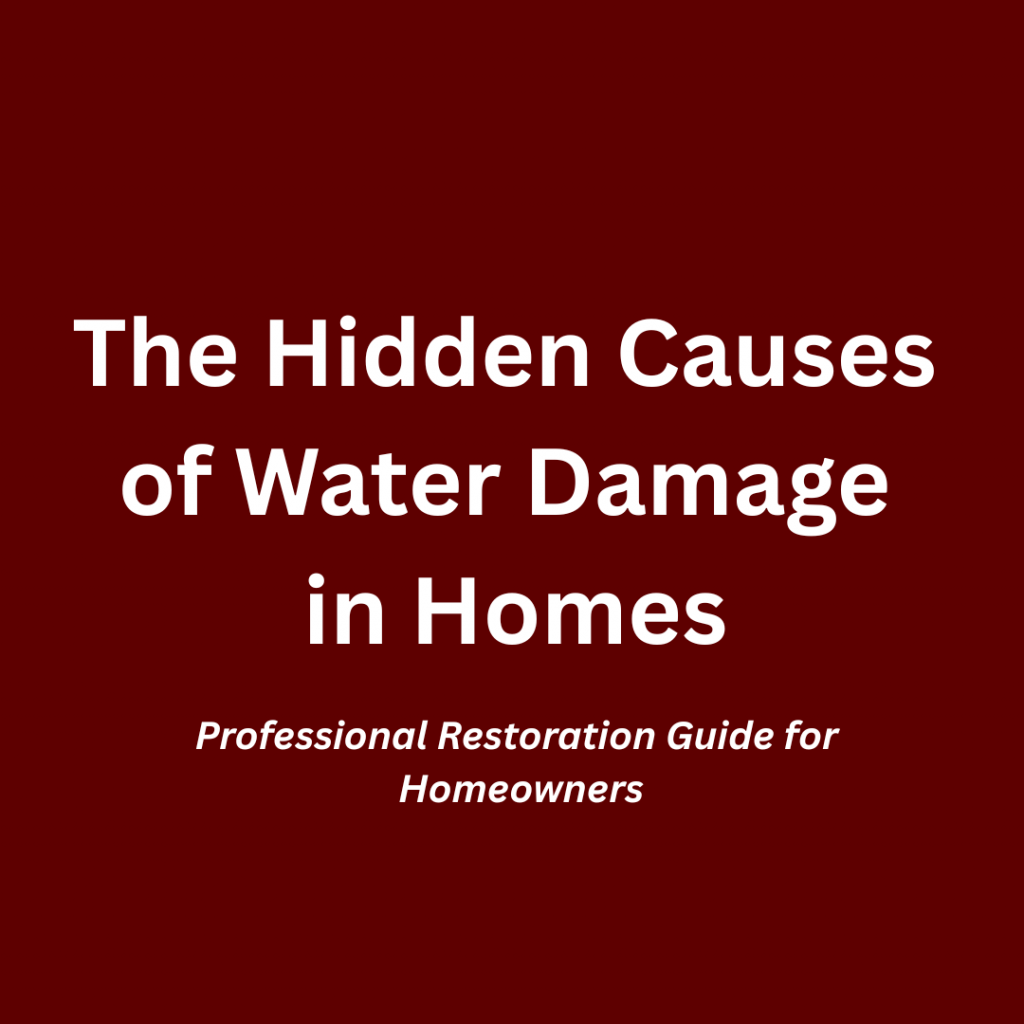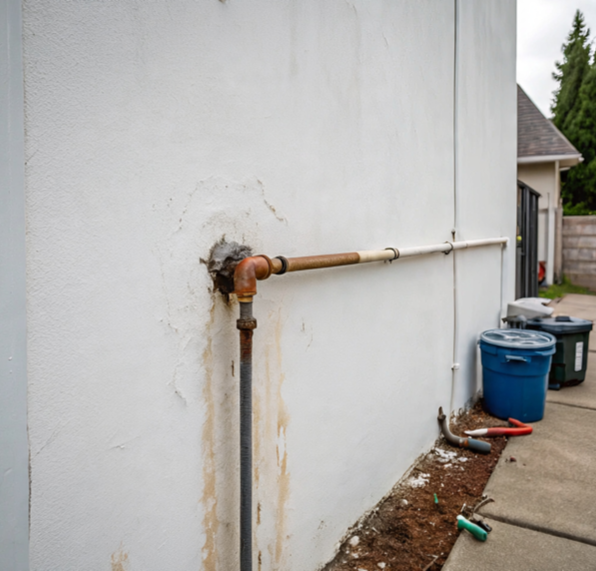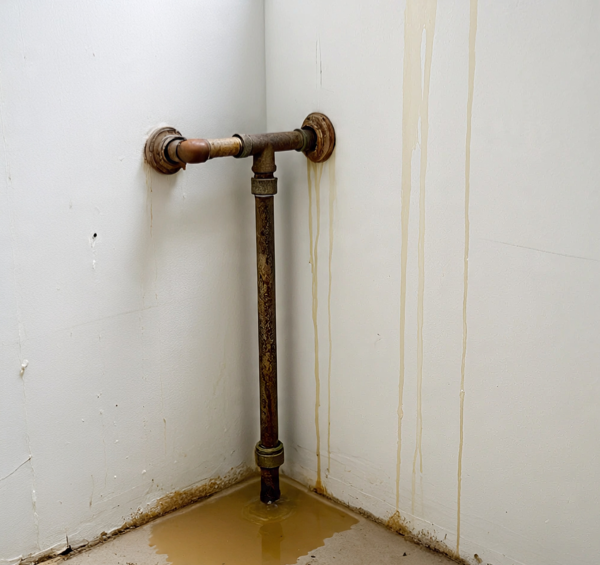Summary
What are the top hidden causes of water damage in homes?
The five most commonly overlooked causes of water damage in homes are: clogged gutters, leaking pipes behind walls, malfunctioning appliances (like dishwashers and water heaters), poor window sealing and flashing, and old caulking or failed sealants in bathrooms and kitchens. These subtle issues can silently lead to structural damage, mold growth, and high repair costs if left unnoticed. Early detection and regular maintenance are the key to prevention.

A Story of When a Small Drip Became a Big Disaster
James and Alicia had just purchased their dream home in a quiet suburban neighborhood. As first-time homeowners, they were careful, diligent, and proud of how well they maintained the property. Every weekend, James mowed the lawn. Alicia kept the interior spotless. But one afternoon, after a heavy summer rain, they noticed a soft bubbling in the paint beneath the living room window.
Assuming it was minor, James patched it up with a fresh coat. A few weeks later, Alicia smelled something musty. They called a contractor just in case. What they discovered shocked them: a slow leak around the window frame had been seeping water into the wall for months. Mold had taken over the insulation, and the wooden structure behind the drywall was rotting.
The total repair bill? Over $14,000.
They had home insurance, but it didn’t cover slow leaks due to neglected maintenance.
What James and Alicia didn’t know is that not all water damage is obvious. And many of the most dangerous causes are the easiest to overlook.
What Are the Most Commonly Missed Sources of Water Damage?
Let’s walk through the top 5 silent threats that could be lurking in your home. These are the causes homeowners rarely think about until it’s too late.
1. Are Your Gutters Actually Causing Indoor Water Damage?
Clogged or poorly routed gutters are one of the most overlooked causes of home water damage. Gutters are meant to direct rainwater away from your roof and foundation. But when they’re clogged with leaves or improperly sloped, water spills over and pools around your foundation.
What can go wrong?
- Foundation cracking or basement flooding
- Water intrusion behind siding
- Roof leaks due to standing water under shingles
Signs to watch for:
- Water pooling around your home after rain
- Overflowing gutters during a storm
- Mold or mildew in your basement
Prevention tip:
Clean your gutters at least twice a year, and make sure downspouts extend at least 3–5 feet from the foundation.
2. Is There a Leak Inside Your Walls You Can’t See?

One of the sneakiest sources of water damage is leaking plumbing behind walls or under floors. These leaks can go unnoticed for months, slowly saturating drywall, wood, or insulation leading to structural weakening and mold growth.
Why it’s dangerous:
Because it’s hidden, you usually don’t notice until the damage is severe.
Common culprits:
- Aging copper or PVC pipes
- Loose pipe joints or fittings
- Unnoticed pinhole leaks
Warning signs:
- Discolored or bubbling paint
- Musty smell, especially after rain or showers
- Unexpected spike in water bills
- Warm spots on floors (especially over slab foundations)
Prevention tip:
Schedule a yearly plumbing inspection, and install a leak detector under major water appliances.
3. Could Your Dishwasher, Fridge, or Water Heater Be Leaking?
Many homeowners forget that water damage can begin in the kitchen or utility room, not just from obvious sources like toilets or showers. Aging appliances can silently leak over time, especially around hoses, valves, and underfloor connectors.
Appliances to watch:
- Dishwashers (leaky seals or drain issues)
- Refrigerators with water lines for ice/water dispensers
- Washing machines (especially older ones)
- Water heaters (sediment buildup can cause cracks)
What to look for:
- Pooling or staining around appliance bases
- Vibrations or abnormal sounds
- Rust on connectors or valves
- Musty odor in laundry or utility rooms
Prevention tip:
Replace rubber hoses with braided stainless steel lines. Check water connectors annually and replace aging appliances before they fail.
4. Are Your Windows and Doors Properly Sealed?
Another common and forgotten entry point for water is through window and door flashing or seals. Over time, caulking degrades, flashing corrodes, and even minor gaps let water in during wind-driven rain.
Why it matters:
Water can seep into your walls, rot framing, ruin insulation, and invite mold.
Tell-tale signs:
- Bubbling or peeling paint around windows
- Drafts or discoloration on interior sills
- Stains or mold near window edges
Prevention tip:
Re-caulk windows and doors every 3–5 years. Check your flashing during any roof or siding work.
5. Is Your Shower or Sink Slowly Leaking Behind the Scenes?
Bathrooms and kitchens are obvious sources of water but sometimes, it’s not the pipes. Failed caulking, poor tile grout, or small drips from under sinks can slowly cause damage.
Common trouble areas:
- Grout lines in the shower that no longer repel water
- Gaps in tub or shower caulk
- Leaks from P-traps under sinks
- Water damage in the cabinet base under sinks
What happens if ignored?
- Subfloor rot
- Tile lifting or cracking
- Persistent mildew
- Dangerous mold behind the walls
Prevention tip:
Re-seal shower and tub edges every 1–2 years, and inspect beneath sinks for any dampness monthly.
What Happens If These Issues Go Unnoticed?

The longer water damage goes undetected, the more extensive and expensive the consequences:
- Mold growth begins within 24–48 hours of moisture exposure
- Drywall and insulation become saturated and must be replaced
- Wood framing can warp, rot, and compromise structural integrity
- Electrical wiring near leaks can become dangerous or short out
- Insurance claims may be denied if damage is due to neglect
Just like in the story of James and Alicia, early signs of damage if ignored can lead to major repairs not covered by insurance.
How Can You Protect Your Home from Overlooked Water Damage?
Here’s a practical prevention checklist:
- Inspect gutters and downspouts twice a year.
- Listen for strange sounds in walls or ceilings.
- Check behind appliances for any dampness or rust.
- Monitor water usage on your bill spikes can mean leaks.
- Touch caulk and grout in your kitchen and bathroom replace if cracked or loose.
- Install smart water leak sensors under sinks and near water heaters.
- Know the age of your appliances and replace when nearing the end of their lifespan.
What’s the Takeaway for Homeowners?
Water damage doesn’t always look like a burst pipe or a flooded basement. Sometimes, it’s a single drop hidden, ignored, and slowly causing thousands in damage.
The biggest mistake homeowners make is assuming “if I can’t see it, it’s not a problem.” But water is persistent, and it always finds a way. Regular inspections, preventative maintenance, and awareness can save you a massive headache down the road.
For immediate assistance with water damage restoration in Greenfield, Indiana, contact PuroClean Disaster Restoration, Call (+1) 317-467-4436.
PuroClean Disaster Restoration has over 19 years of experience in the water damage restoration industry, with over 100 five star ratings on Google serving Indianapolis. Click on this link to see it’s online reviews and ratings.
Frequently Asked Questions (FAQs) on Water Damage Issues
How can I tell if I have a hidden water leak?
Look for signs like discolored paint, a musty smell, unusually high water bills, or warm spots on the floor. Leak detection devices can also help identify hidden leaks early.
Is water damage from a slow leak covered by insurance?
Often, no. Most homeowners’ insurance policies do not cover water damage caused by poor maintenance or slow leaks. Sudden, accidental leaks are typically covered.
How often should I check my gutters?
Gutters should be cleaned and inspected at least twice a year typically in spring and fall.
Should I worry about a dripping faucet or minor leak?
Yes. Even minor leaks can lead to mold, rot, and expensive damage if left unchecked. A single drip can waste gallons of water over time and damage surrounding materials.
What’s the best way to detect a leak under an appliance?
Use a smart leak sensor or moisture detector. You can also check manually for dampness, rust, or staining on the floor beneath or behind the appliance.
Final Thoughts
Water is one of your home’s greatest enemies but also one of the quietest. It doesn’t always burst in through a broken pipe. More often, it creeps in through overlooked gaps, aged seals, and hidden leaks.
Whether you’re a new homeowner or a seasoned pro, don’t fall into the trap of assuming your house is fine just because everything looks okay.
James and Alicia did everything right or so they thought. But a little water behind the wall turned into a major financial setback. The lesson? Prevent the preventable. Know what to look for, take action early, and protect your investment before the damage is done.